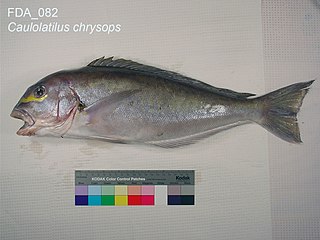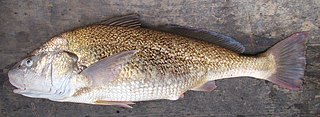
Tilefishes are mostly small perciform marine fish comprising the family Malacanthidae. They are usually found in sandy areas, especially near coral reefs. They have a long life span, up to 46 years (females) and 39 years (males).

The lane snapper, the Mexican snapper, redtail snapper or spot snapper, is a species of marine ray-finned fish, a snapper belonging to the family Lutjanidae. It is native to the western Atlantic Ocean.

The Caesar grunt, also known as the black grunt, blacktail grunt, or redmouth grunt is a species of marine ray-finned fish, a grunt in the family Haemulidae. It is native to the western Atlantic Ocean.

The cubera snapper, also known as the Cuban snapper, is a species of marine ray-finned fish, a snapper belonging to the family Lutjanidae. It is native to the western Atlantic Ocean. It is a commercially important species and is a sought-after game fish, though it has been reported to cause ciguatera poisoning.
The striped croaker, also known as the St Lucian corvina, is a species of marine ray-finned fish belonging to the family Sciaenidae, the drums and croakers. This species is found in the western Atlantic Ocean in the Caribbean Sea and Gulf of Mexico.

The ocean whitefish, also known as the ocean tilefish, is a species of marine ray-finned fish, a tilefish belonging to the family Malacanthidae. It is native to the eastern Pacific Ocean.

Caulolatilus cyanops, the blackline tilefish or ocean whitefish, is a species of marine ray-finned fish, a tilefish belonging to the family Malacanthidae. It is found in the western Atlantic Ocean.

The blue blanquillo, also known as the banded blanquillo, striped blanquillo, false whiting, sand tilefish or eye of the sea, is a species of marine ray-finned fish, a tilefish belonging to the family Malacanthidae. It is found in the Indo-Pacific.

Branchiostegus is a genus of marine ray-finned fishes, tilefishes, belonging to the family Malacanthidae. They are found in the eastern Atlantic Ocean through the Indian Ocean to the western Pacific Ocean. Here they create burrows in soft substrates in the comparatively deep waters of the continental shelf and slope.

Caulolatilus is a genus of tilefishes native to the Pacific and Atlantic coasts of the Americas. This genus is regarded as the least specialised and the most basal of the tilefishes.

The blackbar drum is a species of marine ray-finned fish belonging to the genus Pareques in the family Sciaenidae, the drums and croakers. It is found in the western Atlantic Ocean.

Malacanthus brevirostris, the quakerfish, flagtail blanquillo, false whiting or stripetail tilefish, is a species of marine ray-finned fish, a tilefish belonging to the family Malacanthidae. It has a wide Indo-Pacific distribution.

Caulolatilus chrysops, the Atlantic goldeneye tilefish or gold face tilefish, is a species of marine ray-finned fish, a tilefish belonging to the family Malacanthidae. It occurs in the western Atlantic Ocean.

Malacanthus plumieri, the sand tilefish, is a species of marine ray-finned fish, a tilefish belonging to the family Malacanthidae. It is found in the western Atlantic Ocean.

Apsilus dentatus, the black snapper, is a species of marine ray-finned fish, a snapper belonging to the family Lutjanidae. It is found in the western Atlantic Ocean.

Lutjanus novemfasciatus, the Pacific cubera snapper or Pacific dog snapper, is a species of marine ray-finned fish, a snapper belonging to the family Lutjanidae. It is native to the eastern Pacific Ocean.

The silk snapper, the West Indian snapper, yellow-eyed snapper or yellow-eyed red snapper, is a species of marine ray-finned fish, a snapper belonging to the family Lutjanidae. It is found in the Western Atlantic Ocean.

Lepidotrigla spiloptera, the spotwing gurnard, spotfin gurnard or red-fringed gurnard, is a species of marine, demersal ray-finned fish from the family Triglidae, the gurnards and sea robins. It has a wide Indo-Pacific distribution.
The Atlantic rubyfish, also known as the crimson rover, is a species of marine ray-finned fish belonging to the family Emmelichthyidae, the rovers, bonnetmouths and rubyfishes. This fish is found in the eastern and western central Atlantic Ocean.

Micropogonias furnieri, the whitemouth croaker, golden croaker, hardhead, mangrove snapper, rocandoronco, two-belly bashaw, West Indian croaker, West Indian drum or whitemouth drummer, is a species of marine ray-finned fish belonging to the family Sciaenidae, the drums and croakers. This fish is found in the western Atlantic Ocean.


















